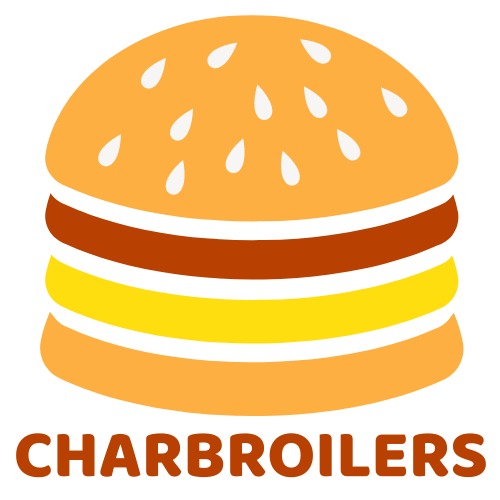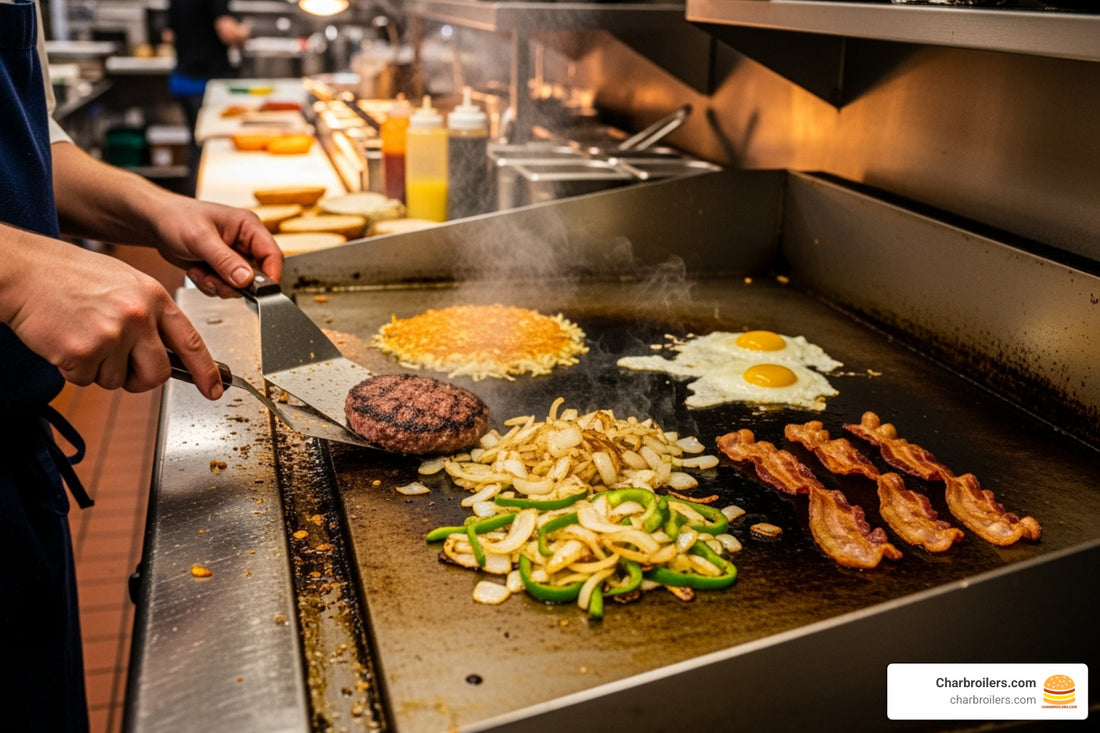
The Hot Plate Handbook: Mastering Commercial Griddles and Flat Top Grills
Share
Why a Commercial Kitchen Griddle is Your Restaurant's Secret Weapon
A commercial kitchen griddle is one of the most versatile and essential pieces of equipment in any professional kitchen. Whether you're flipping pancakes for the breakfast rush, searing burgers for lunch, or cooking up dinner specials, the right griddle can transform your kitchen's efficiency and expand your menu possibilities.
Quick Guide to Choosing a Commercial Kitchen Griddle:
- Gas vs. Electric: Gas heats faster, while electric offers more precise control.
- Size Options: 24", 36", 48", 60", or 72" widths to match your volume.
- Plate Thickness: 1/2" for light use, 3/4" to 1" for high-volume kitchens.
- Control Types: Manual, snap-action, or solid-state thermostats.
- Key Features: Independent heat zones, thick steel plates, and easy-to-clean designs.
During a busy service, your griddle becomes the workhorse that keeps every order moving smoothly. From gas models with infrared technology that can reduce energy costs to electric units with precise temperature control, today's commercial griddles offer advanced features that boost both efficiency and food quality. Some electric griddles provide 4000 watts of power per 12 inches of cooking surface, while certain brands offer widths up to 72 inches for high-volume operations.
Choosing the right griddle isn't just about size and power. Plate thickness matters tremendously—a 3/4" thick polished steel plate retains heat better and recovers faster between orders. Some griddles even feature specialized chromium surfaces that can reduce cleanup time while cooking food faster at lower temperatures. The right equipment choice can make or break a kitchen's efficiency during those crucial rush periods.
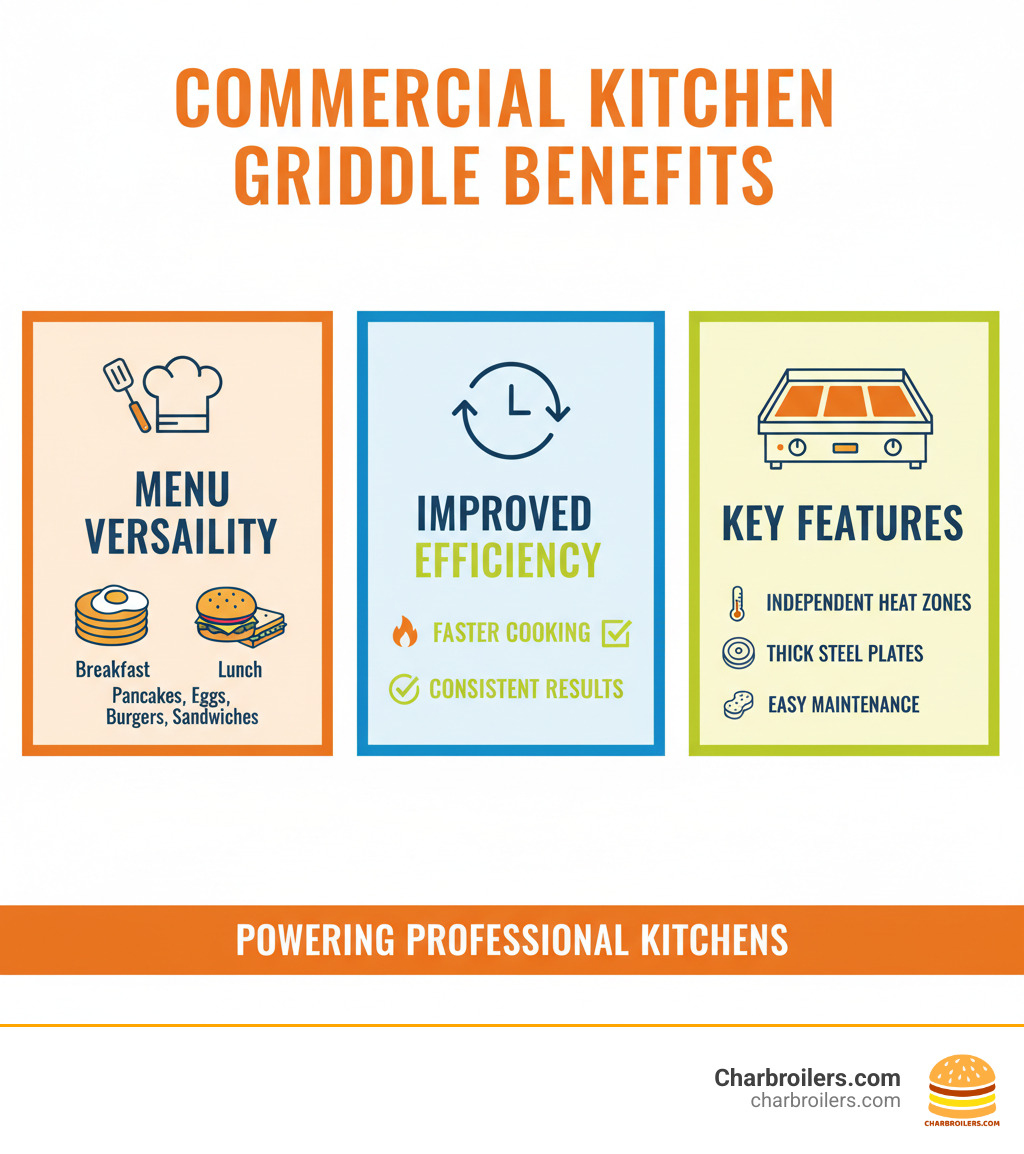
Commercial kitchen griddle definitions:
- commercial oven with griddle
- how to clean a commercial stainless steel griddle
- commercial gas stove 48 inch
Understanding the Types of Commercial Griddles
Choosing a commercial kitchen griddle involves understanding the different types available. Each serves a specific purpose, and the main decisions revolve around the power source (gas or electric), cooking surface (flat or grooved), and installation style (countertop or drop-in). Finding the right griddle means matching the equipment to your menu, kitchen layout, and cooking style.
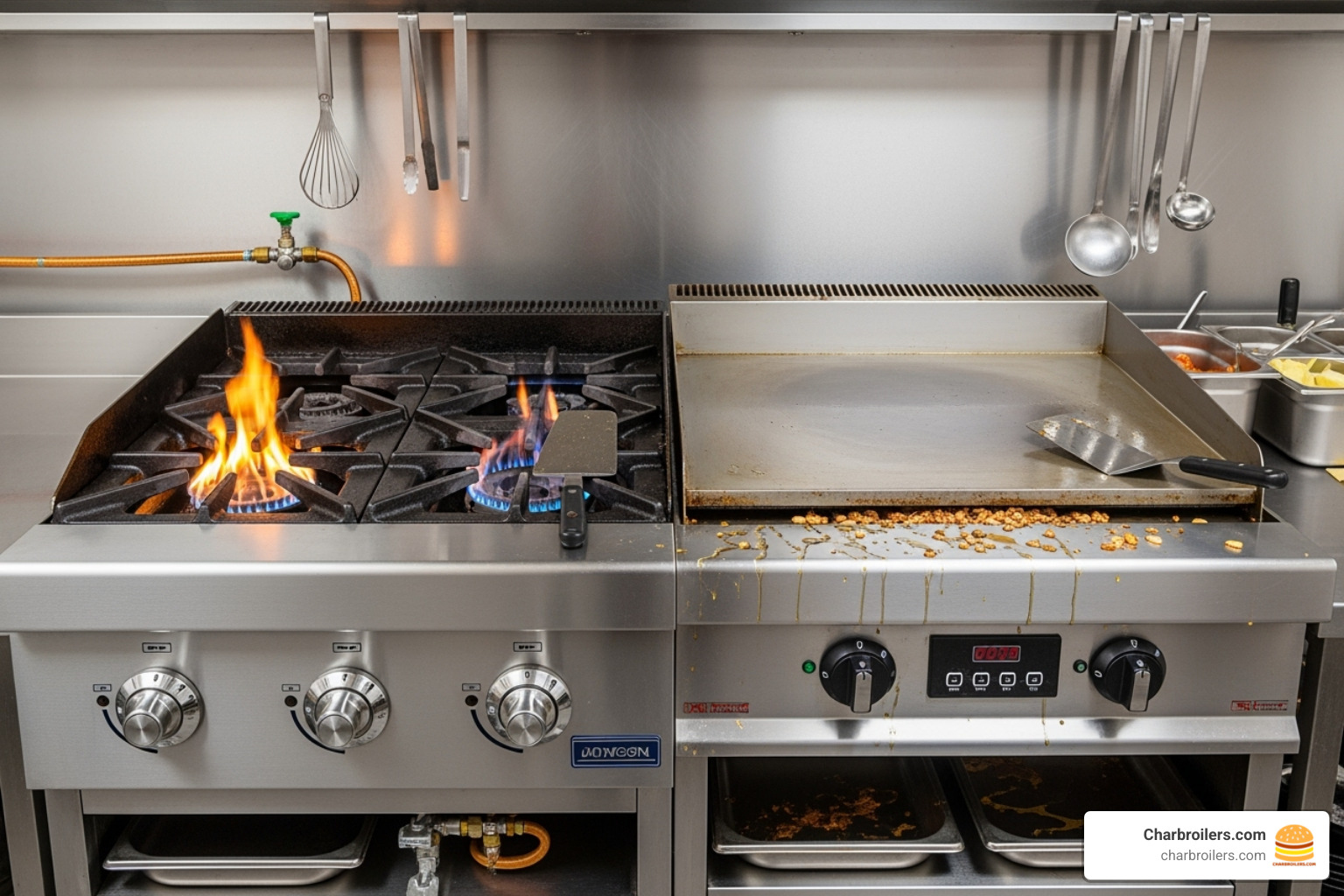
Gas vs. Electric Griddles: Powering Your Performance
Gas griddles are known for heating up fast and responding immediately to temperature adjustments. Many chefs prefer this instant feedback, especially during busy rushes. Gas models come in sizes from 24-inch units to massive 72-inch workhorses. Newer gas griddles may feature technology like infrared burners that can reduce gas costs while delivering consistent heat. However, gas griddles require proper ventilation systems, which should be factored into your kitchen plan.
Electric griddles are the precision players. They are known for their 1-inch thick plates that distribute heat incredibly evenly, eliminating hot spots. Some electric griddles deliver 4000 watts of power per 12 inches of cooking surface, with snap-action thermostats that allow for exact temperatures from 150° to 450°F. Electric units also typically require less complex ventilation, which can save money and hassle during installation.
The choice between gas and electric often comes down to your kitchen's existing setup and whether you prioritize the rapid heat changes of gas or the precise temperature control of electric.
For a detailed comparison of 36-inch models, check out our guide: 36" Commercial Griddles: Gas vs. Electric and Top Picks.
Flat Top vs. Grooved Griddles: Surface-Level Decisions
The cooking surface you choose can completely change your menu possibilities. Flat top griddles are the ultimate multitaskers, handling everything from fluffy pancakes and fried eggs to sizzling burgers and grilled cheese sandwiches. The even heat distribution means you can use the entire surface, and cleanup is straightforward.
Grooved griddles are designed to create restaurant-quality grill marks on steaks, chicken, and vegetables. The grooves also help with fat drainage, which is an advantage when cooking proteins. If your menu features many grilled items but you want more control than a traditional charbroiler offers, a grooved surface might be perfect.
Most operations find that flat tops offer the most versatility for high-volume cooking. But if your concept revolves around grilled items with that signature look, grooved surfaces can lift your food's presentation.
To explore more flat top options and find the perfect fit for your menu, read: The Ultimate Commercial Flat-Top Grill Roundup: Sizzle Up Your Menu.
Key Factors for Choosing Your Commercial Kitchen Griddle
Picking the right commercial kitchen griddle becomes much clearer once you know what to look for. The size, power, controls, materials, and plate thickness all need to align with your kitchen's specific needs and volume.
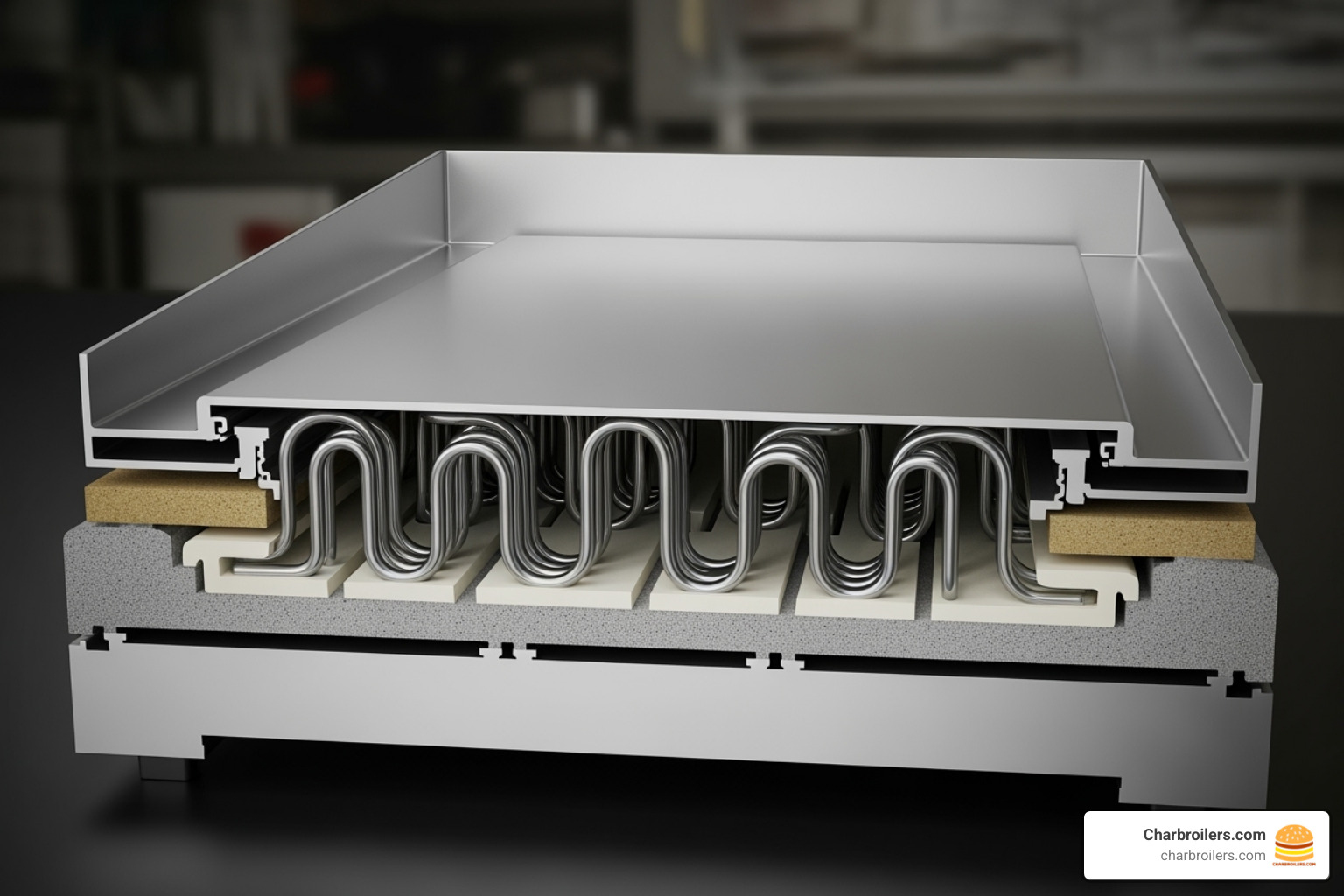
Size and Cooking Surface Area
Griddle size isn't just about fitting it in your kitchen; it's about matching your busiest day's output. Griddle widths typically range from 15-inch models up to massive 72-inch workhorses. Common sizes include 24-inch, 36-inch, 48-inch, and 60-inch options.
Cooking depth also matters. Some models offer extra-deep 30-inch plates, giving you more cooking real estate without taking up more linear counter space. However, ensure the griddle's footprint doesn't crowd your prep space or block traffic flow, as that can create more problems than it solves.
For deeper insights on sizing decisions, check out: 48-Inch Commercial Flat-Top Grill Guide: Cooking Up Success 60" Commercial Griddles: Heavy-Duty Solutions for High-Volume
Griddle Plate Deep Dive: Material and Thickness
If the griddle plate is the heart of your commercial kitchen griddle, then thickness is its strength. This determines the difference between consistent cooking and frustrating temperature swings.
Most commercial griddles use polished steel plates.
- 1/2-inch plates work well for lighter operations with moderate griddle use.
- 3/4-inch plates are a significant step up, holding heat much better. When you drop cold food on the surface, it doesn't lose temperature as dramatically.
- 1-inch thick plates are for serious, high-volume kitchens. These hefty plates offer superior heat distribution and recovery. The thicker plate stores more heat energy, so the temperature stays rock-steady.
Excellent heat retention and recovery time directly impact your kitchen's efficiency and lead to lower energy costs. Some griddles also feature a specialized trivalent chromium surface that helps food cook faster at lower temperatures with less shrinkage, while also making cleanup significantly easier.
Learn more about plate construction in our guide: Commercial Gas Griddle.
Understanding Griddle Controls and Zones
The controls on your commercial kitchen griddle determine how precisely you can manage your cooking.
- Manual controls are simple, reliable knobs that adjust heat output, but they require experienced cooks who can judge temperatures by sight and sound.
- Snap-action thermostats bring more precision, automatically cycling on and off to maintain set temperatures. These controls often offer a range from 150° to 450°F and are placed close to the cooking surface for a quick response.
- Solid-state controls are electronic systems that offer the highest accuracy and stability, ideal for operations where consistency is critical.
Independent cooking zones are another game-changing feature. Many models let you set different temperatures across different sections of the same griddle. This allows you to keep food warm on one end, cook at medium heat in the middle, and sear on high heat at the other end—all simultaneously. This zone control transforms your griddle into a multi-tasking powerhouse.
For more details on control options, visit: The Ultimate Atosa Griddle Guide: Manual, Thermostatic, and Beyond.
Maximizing Efficiency with Modern Features and Accessories
In today's commercial kitchens, a commercial kitchen griddle must be a productivity powerhouse. Modern griddles come packed with clever technologies and thoughtful accessories that can transform your kitchen workflow.
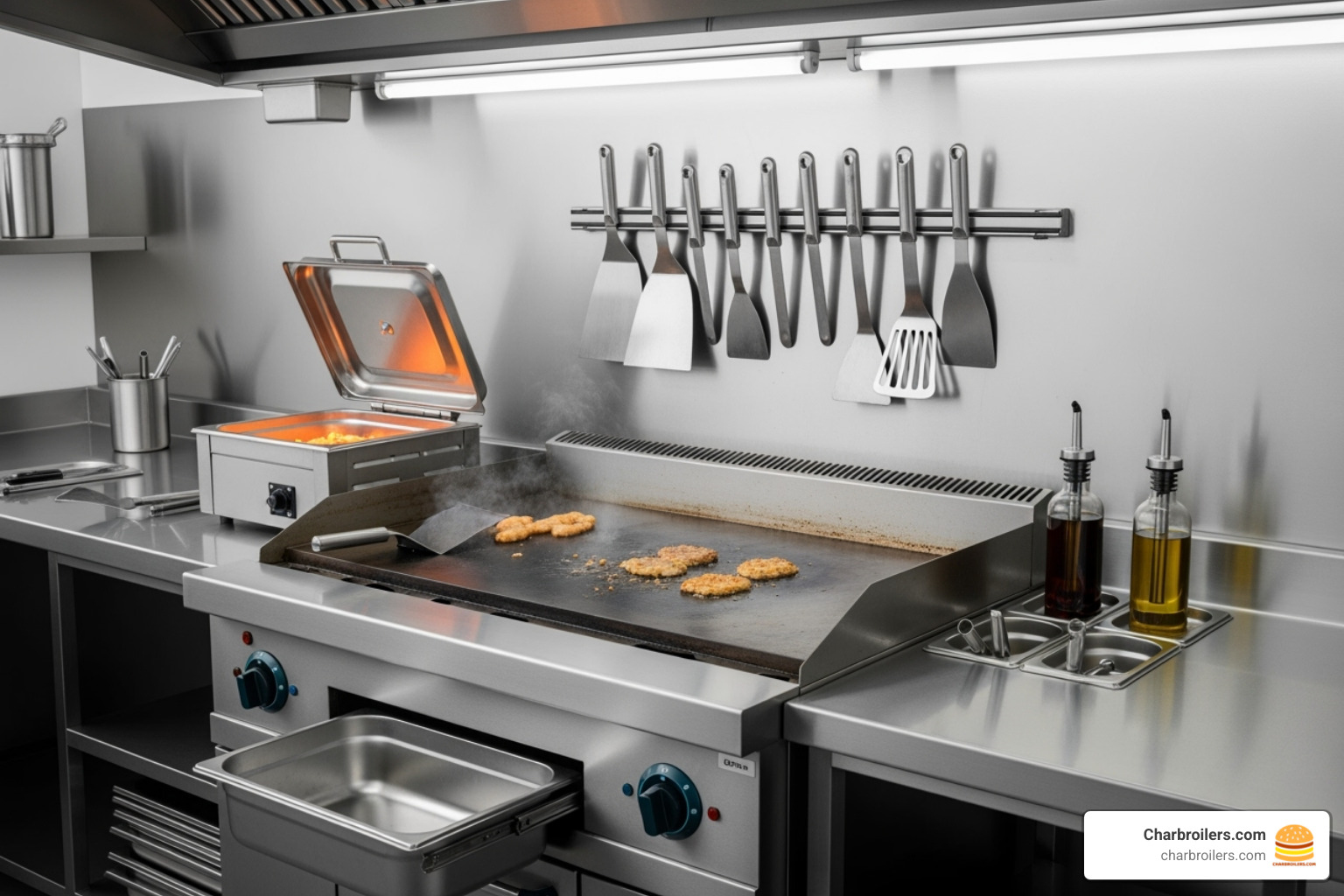
Innovative Technology in a Modern Commercial Kitchen Griddle
Today's commercial kitchen griddle is a sophisticated piece of equipment designed to save you money while delivering better results.
Infrared burner technology, for example, is engineered to reduce your gas spending while delivering more consistent heat. This means your food cooks more evenly and your energy bills stay lower. Electric griddles have their own innovations, with some models packing 4000-watt elements every 12 inches of cooking surface. That's enough power to recover quickly when cold food is placed on the griddle, keeping cooking times consistent.
For operators serious about controlling costs, ENERGY STAR® certified models offer long-term savings. These griddles meet strict energy efficiency guidelines, translating to lower utility bills. Another game-changer is advanced thermostat technology. Whether it's snap-action controls or solid-state systems, these features take the guesswork out of cooking. Some unique surfaces even retain heat within the plate itself, allowing food to cook faster at lower temperatures, resulting in significant energy savings.
For more on smart griddling, explore: Smart Griddling: Why Atosa ATTG Models Are a Must-Have.
Essential Accessories to Boost Productivity
A great commercial kitchen griddle becomes extraordinary when paired with the right accessories.
- Clamshell tops are perhaps the most transformative accessory, cooking both sides of a food item like a burger simultaneously and cutting cook times in half.
- Backsplash extenders and sidebars protect your walls from grease splatter and create a contained cooking area, making cleanup easier and giving you better control.
- Pan holders and shelf accessories keep spatulas, oil bottles, and seasonings within arm's reach, eliminating wasted motion and saving valuable time.
These accessories turn your griddle area into a well-organized command center. For more ways to organize your kitchen, see: Restaurant Prep Tables.
The Benefits of a Griddle in Your Kitchen Workflow
A well-chosen commercial kitchen griddle revolutionizes how your entire kitchen operates. The menu versatility is remarkable, allowing you to cook breakfast, lunch, and dinner items on the same piece of equipment.
For high-volume output, the large, flat cooking surface can handle multiple orders simultaneously. Consistent food quality is where thick griddle plates and precise controls shine, ensuring every item is cooked perfectly. This consistency builds customer loyalty and reduces waste. Perhaps most importantly, a griddle can significantly reduce ticket times by allowing you to cook multiple components at once, leading to happier customers and higher table turnover.
Want to know more about griddle benefits? Check out: Griddle Me This: Why the Atosa 24 Griddle is a Must-Have.
Essential Maintenance for Your Commercial Griddle
Taking care of your commercial kitchen griddle is an investment in consistent food quality and kitchen efficiency. A little daily attention goes a long way toward keeping this workhorse running smoothly for years. A well-maintained griddle heats evenly, cooks food properly, and won't let you down during a rush.
Proper care protects your investment and can prevent costly repairs. For specific maintenance schedules and detailed procedures, it's always wise to check your griddle's user manual to get familiar with its requirements.
Daily Cleaning and Seasoning Your Commercial Kitchen Griddle
The secret to a long-lasting commercial kitchen griddle starts with daily cleaning. This prevents food buildup that can affect taste, create hot spots, and damage your equipment.
While your griddle is still warm, use a griddle scraper to push food debris and excess grease into the collection area. Next, apply a commercial degreaser designed for griddles, then scrub the surface with a griddle brick or pad. Some advanced surfaces can cut cleanup time significantly, but even they need daily attention.
Don't forget the grease management system. Grease traps need daily emptying and cleaning to prevent overflows and maintain a sanitary environment.
Seasoning is the final crucial step. After cleaning, apply a thin coat of food-safe oil to the warm surface, let it heat until it begins to smoke, then allow it to cool. This creates a non-stick, protective layer that makes cooking easier and prevents rust.
For a complete step-by-step guide, check out: The Ultimate Guide to Cleaning a Commercial Stainless Steel Griddle.
Long-Term Care and Safety Compliance
Beyond daily cleaning, your commercial kitchen griddle needs periodic attention to stay safe and efficient.
Regular thermostat calibration ensures your temperature controls remain accurate, which is crucial for consistent results and food safety. Routinely check gas connections for leaks and inspect power cords on electric models for damage. Look for uneven heating patterns that might indicate burner problems or plate warping. Catching these issues early prevents bigger problems later.
Safety certifications are your assurance that the equipment meets strict standards. Many models carry ETL certification for safety and NSF compliance for commercial food service. Maintaining compliance with these standards is often required by health departments and is essential for safe operation.
Troubleshooting becomes easier when you know what to look for. Uneven heat distribution often signals burner or thermostat problems. Addressing these promptly keeps your kitchen running smoothly.
Learn more about maintaining gas models in our guide: Gas Griddle Commercial.
Frequently Asked Questions about Commercial Griddles
How thick should my griddle plate be?
Plate thickness directly impacts your griddle's performance. For light-duty operations with moderate volume, a 1/2-inch thick plate is sufficient. For a high-volume kitchen, you should invest in a 3/4-inch to 1-inch thick plate.
Thicker plates are champions of heat retention. When you place cold food on the griddle, a thin plate loses temperature and takes time to recover. A thick plate maintains a consistent cooking temperature, allowing for faster recovery between orders and better food quality.
Is a gas or electric griddle better?
This depends on your kitchen's needs.
Gas griddles heat up very fast and respond immediately to temperature changes. If your kitchen uses natural gas or propane, they can also be more cost-effective to operate, depending on local utility rates. However, they require proper ventilation.
Electric griddles are masters of precision. They provide incredibly consistent temperatures across the entire cooking surface thanks to powerful, evenly distributed heating elements and advanced thermostats. They are also generally easier to install as they don't have the same ventilation requirements as gas models.
The best choice depends on your available utilities, energy costs, and cooking style.
What are the most important features to look for?
When choosing a commercial kitchen griddle, prioritize these key features:
- A thick griddle plate (3/4-inch to 1-inch) is non-negotiable for high-volume cooking. It holds heat effectively and recovers quickly, ensuring food quality and consistency during busy periods.
- Reliable thermostatic controls (snap-action or solid-state) provide the precise temperature management needed for consistent results.
- Durable stainless steel construction ensures your griddle can withstand the demands of a commercial kitchen while remaining easy to clean.
- Independent cooking zones offer great versatility, allowing you to set different temperatures on different sections of the griddle to cook multiple items at once.
- An effective grease management system with a large, easy-to-clean grease trap will save you time and hassle every day.
Conclusion
Choosing the right commercial kitchen griddle is a smart investment in your restaurant's success. As we've covered, getting the fundamentals right—like choosing a 3/4-inch to 1-inch thick plate for heat retention, investing in reliable thermostatic controls for consistency, and selecting the right size for your volume—is critical for kitchen efficiency.
Modern griddles offer innovations that boost productivity and your bottom line. However, even the best equipment requires proper care. The daily cleaning and maintenance routines we discussed are essential to keep your investment running strong for years.
At Charbroilers.com, we've helped countless kitchen operators find their perfect commercial kitchen griddle. Whether you need a compact model for a small café or a large powerhouse for a busy diner, the right griddle is waiting to transform your kitchen's capabilities.
Ready to explore more ways to upgrade your commercial kitchen? Explore our complete guide to commercial kitchen equipment and find how the right equipment choices can sizzle up success for your entire operation.
